The global nuclear engineering service market is valued at USD 33,208 million in 2025 and is set to reach USD 64,115 million by 2035, growing at a CAGR of 6.8%. The nuclear engineering service market stands at the forefront of a transformative decade that promises to redefine nuclear infrastructure development and operational excellence across power generation, medical applications, industrial processes, and defense sectors. The nuclear engineering service market's journey from USD 33,208 million in 2025 to USD 64,115 million by 2035 represents substantial growth, demonstrating the accelerating adoption of advanced nuclear technologies and comprehensive engineering solutions across nuclear power facilities, medical isotope production, industrial radiography, and military nuclear systems.
The first half of the decade (2025-2030) will witness the nuclear engineering service market climbing from USD 33,208 million to approximately USD 45,832 million, adding USD 12,624 million in value, which constitutes 41% of the total forecast growth period. This phase will be characterized by the rapid deployment of next-generation reactor designs, driven by increasing demand for clean energy solutions and enhanced safety protocols worldwide. Advanced modular reactor technologies and digital instrumentation systems will become standard expectations rather than premium options.
The latter half (2030-2035) will witness sustained growth from USD 45,832 million to USD 64,115 million, representing an addition of USD 18,283 million or 59% of the decade's expansion. This period will be defined by mass market penetration of small modular reactors, integration with comprehensive energy management platforms, and seamless compatibility with existing grid infrastructure. The nuclear engineering service market trajectory signals fundamental shifts in how utilities and governments approach nuclear energy deployment, with participants positioned to benefit from sustained demand across multiple application segments.
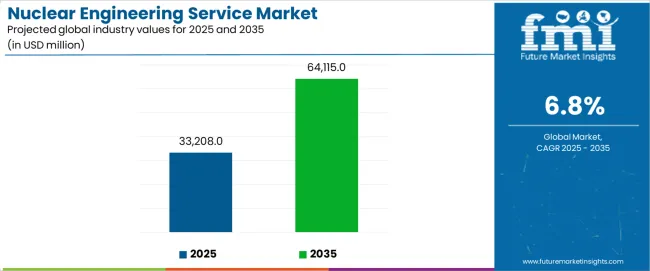
The Nuclear Engineering Service Market demonstrates distinct growth phases with varying technological characteristics and regulatory dynamics. Between 2025 and 2030, the nuclear engineering service market progresses through its advanced reactor deployment phase, expanding from USD 33,208 million to USD 45,832 million with steady annual increments averaging 6.6% growth. This period showcases the transition from traditional pressurized water reactor maintenance to advanced small modular reactor construction with enhanced safety systems and digital control technologies becoming mainstream features.
The 2025-2030 phase adds USD 12,624 million to market value, representing 41% of total decade expansion. Market maturation factors include standardization of safety protocols, declining construction costs for modular systems, and increasing regulatory acceptance of advanced reactor designs reaching 85-90% effectiveness in licensing applications. Competitive landscape evolution during this period features established engineering firms like AFRY and Westinghouse Nuclear expanding their service portfolios while specialized contractors focus on decommissioning solutions and advanced fuel cycle management.
From 2030 to 2035, market dynamics shift toward comprehensive lifecycle management and multi-sector deployment, with growth accelerating from USD 45,832 million to USD 64,115 million, adding USD 18,283 million or 59% of total expansion. This phase transition logic centers on universal advanced reactor systems, integration with smart grid technologies, and deployment across diverse energy scenarios, becoming standard rather than specialized nuclear formats. The competitive environment matures with focus shifting from basic construction to comprehensive operational optimization and integration with renewable energy systems.
| Metric | Value |
|---|---|
| Market Value (2025) | USD 33,208 million |
| Market Forecast (2035) | USD 64,115 million |
| Growth Rate | 6.80% CAGR |
| Leading Service Type | Nuclear Power Plant Design and Construction Services |
| Primary Application | Energy Sector |
The nuclear engineering service market demonstrates strong fundamentals with nuclear power plant design and construction services capturing a dominant share through superior engineering capabilities and comprehensive project management expertise. Energy applications drive primary demand, supported by increasing clean energy requirements and enhanced nuclear safety management solutions. Geographic expansion remains concentrated in developed markets with established nuclear regulatory frameworks, while emerging economies show accelerating adoption rates driven by energy security initiatives and carbon reduction commitments.
Market expansion rests on three fundamental shifts driving adoption across energy and industrial sectors. Clean energy transition creates compelling advantages through nuclear engineering systems that provide carbon-free baseload generation with reliable operational performance, enabling utilities to meet decarbonization goals and maintain grid stability while ensuring long-term energy security and justifying investment over fossil fuel alternatives. Energy security modernization accelerates as nations worldwide seek reliable power generation systems that deliver energy independence directly to national infrastructure, enabling strategic autonomy that aligns with geopolitical stability expectations and maximizes energy supply reliability. Climate change mitigation drives adoption from governments requiring clean energy solutions that maximize carbon reduction while maintaining industrial competitiveness during the global energy transition.
However, growth faces headwinds from regulatory complexity that differs across jurisdictions regarding licensing requirements and safety protocols, potentially limiting deployment flexibility in markets with lengthy approval processes. Public perception challenges also persist regarding nuclear safety concerns and waste management issues that may increase community acceptance barriers in regions with demanding environmental advocacy.
The Nuclear Engineering Service Market represents a compelling intersection of clean energy innovation, advanced reactor technology, and comprehensive engineering management. With robust growth projected from USD 33,208 million in 2025 to USD 64,115 million by 2035 at a 6.80% CAGR, this market is driven by increasing energy security requirements, decarbonization initiatives, and global demand for reliable baseload power generation.
The nuclear engineering service market's expansion reflects a fundamental shift in how utilities and governments approach nuclear energy infrastructure. Strong growth opportunities exist across diverse applications, from power generation operations requiring comprehensive plant lifecycle services to medical facilities demanding specialized isotope production capabilities. Geographic expansion is particularly pronounced in Asia-Pacific markets, led by China (9.2% CAGR) and India (8.5% CAGR), while established markets in North America and Europe drive innovation and specialized technology development.
The dominance of nuclear power plant design and construction services and energy sector applications underscores the importance of proven engineering expertise and regulatory compliance in driving adoption. Technical complexity and safety requirements remain key challenges, creating opportunities for companies that can deliver consistent performance while maintaining rigorous safety standards.
Primary Classification: The market segments by service type into Nuclear Power Plant Design and Construction Services, Nuclear Reactor Operation and Maintenance Services, Nuclear Fuel Cycle Services, Nuclear Decommissioning and Waste Management Services, and specialized consulting categories, representing the evolution from basic reactor support to comprehensive lifecycle management for nuclear facilities.
Secondary Breakdown: Application segmentation divides the nuclear engineering service market into Energy, Medical, Industrial, Aerospace and Defense, and Research sectors, reflecting distinct requirements for safety protocols, regulatory compliance, and technical specifications.
Regional Classification: Geographic distribution covers North America, Europe, Asia Pacific, Latin America, and the Middle East & Africa, with developed markets leading regulatory frameworks while emerging economies show accelerating growth patterns driven by energy infrastructure development programs.
The segmentation structure reveals technology progression from conventional reactor services toward integrated digital platforms with enhanced monitoring and predictive maintenance capabilities, while application diversity spans from power generation operations to medical isotope production requiring comprehensive safety management and regulatory compliance solutions.
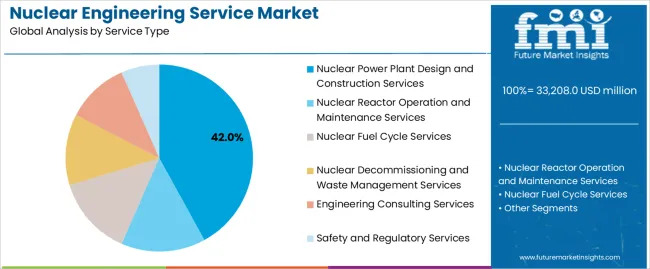
Nuclear power plant design and construction services segment is estimated to account for 42% of the Nuclear Engineering Service Market share in 2025. The segment's leading position stems from its fundamental role as a critical component in nuclear infrastructure development and its extensive use across multiple power generation and industrial applications. The segment's dominance is attributed to its comprehensive project scope, including advanced reactor design capabilities, construction management expertise, and integrated safety systems that make it indispensable for new nuclear facility development worldwide.
Market Position: Nuclear power plant design and construction services command the leading position in the Nuclear Engineering Service Market through advanced engineering methodologies, including comprehensive safety analysis, environmental impact assessment, and regulatory compliance management that enable utilities to deploy nuclear facilities across diverse energy environments.
Value Drivers: The segment benefits from utility preference for turnkey engineering solutions that provide exceptional project coordination without requiring multiple contractor relationships. Integrated project management processes enable deployment in commercial reactors, government facilities, and research installations where technical reliability and regulatory compliance represent critical selection requirements.
Competitive Advantages: Nuclear power plant design and construction services differentiate through comprehensive lifecycle planning, proven safety performance, and compatibility with advanced reactor technologies that enhance energy generation capabilities while maintaining rigorous safety profiles suitable for diverse regulatory jurisdictions.
Key market characteristics:
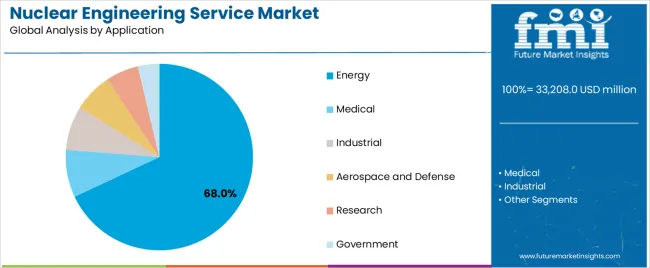
Energy segment is projected to hold 68% of the Nuclear Engineering Service Market share in 2025. The segment's market leadership is driven by the extensive use of nuclear engineering services in power generation, grid stability, and baseload electricity production, where nuclear technologies serve as both a clean energy source and reliable generation solution. The energy sector's consistent demand for advanced nuclear services supports the segment's dominant position.
Market Context: Energy applications dominate the nuclear engineering service market due to widespread adoption of nuclear power generation and increasing focus on carbon-free electricity, grid reliability, and energy security that enhance national energy independence while maintaining industrial competitiveness.
Appeal Factors: Utility operators prioritize operational excellence, safety performance, and integration with existing grid infrastructure that enable coordinated deployment across multiple generation portfolios. The segment benefits from substantial government support and climate initiatives that emphasize clean energy systems for national energy applications.
Growth Drivers: National energy policies incorporate nuclear power as standard components for decarbonization and energy security programs. At the same time, utility modernization initiatives are increasing demand for advanced reactor technologies that comply with environmental standards and enhance operational efficiency.
Market Challenges: Regulatory complexity and public acceptance issues may limit deployment flexibility in politically sensitive markets or regions with anti-nuclear sentiment.
Application dynamics include:
Growth Accelerators: Clean energy mandates drive primary adoption as nuclear engineering services provide exceptional carbon-free generation capabilities that enable climate goals without grid reliability compromise, supporting decarbonization objectives and energy security that require proven nuclear technologies. Energy independence accelerates market expansion as nations seek reliable power generation systems that maintain industrial competitiveness during geopolitical uncertainty while enhancing national security through domestic energy production. Technology advancement increases worldwide, creating sustained demand for next-generation reactor systems that complement energy portfolios and provide operational advantages in clean electricity generation.
Growth Inhibitors: Regulatory complexity challenges differ across jurisdictions regarding licensing timelines and safety requirements, which may limit project predictability and capital planning in markets with demanding approval processes and lengthy environmental reviews. Public perception concerns persist regarding nuclear safety and waste management that may increase community resistance in regions with strong environmental advocacy. Capital intensity across multiple reactor designs and safety systems creates financing barriers between different project scales and existing energy infrastructure investments.
Market Evolution Patterns: Adoption accelerates in energy and industrial sectors where carbon reduction benefits justify nuclear investments, with geographic concentration in developed markets transitioning toward mainstream deployment in emerging economies driven by energy security and climate commitments. Technology advancement focuses on enhanced safety systems, simplified construction methods, and integration with digital monitoring platforms that optimize reactor performance and regulatory compliance. The nuclear engineering service market could face disruption if renewable energy costs or energy storage technologies significantly challenge nuclear advantages in baseload generation applications.
The Nuclear Engineering Service Market demonstrates varied regional dynamics with growth leaders including China (9.2% CAGR) and India (8.5% CAGR) driving expansion through massive nuclear infrastructure development and energy security initiatives. Steady Performers encompass Germany (7.8% CAGR), Brazil (7.1% CAGR), the USA (6.5% CAGR), the UK (5.8% CAGR), and Japan (5.1% CAGR), benefiting from established nuclear industries and advanced technology deployment.
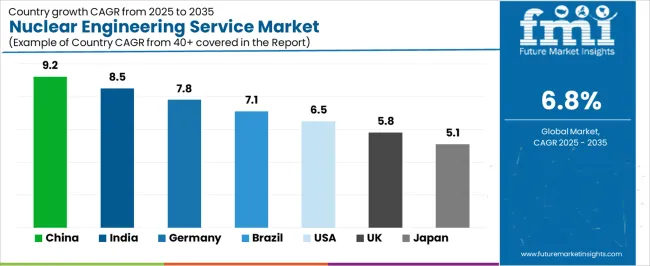
| Country | CAGR (2025-2035) |
|---|---|
| China | 9.2% |
| India | 8.5% |
| Germany | 7.8% |
| Brazil | 7.1% |
| USA | 6.5% |
| UK | 5.8% |
| Japan | 5.1% |
Regional synthesis reveals Asia-Pacific markets leading growth through nuclear capacity expansion and energy infrastructure modernization, while European countries maintain steady expansion supported by clean energy transition and reactor lifetime extension programs. North American markets show strong growth driven by advanced reactor development and existing fleet optimization.
China establishes regional leadership through massive nuclear capacity expansion and comprehensive energy security modernization, integrating advanced nuclear engineering services as standard components in national energy policy and industrial development operations. The country's 9.2% CAGR through 2035 reflects ambitious nuclear deployment promoting energy independence and carbon reduction infrastructure that mandate the use of advanced reactor systems in power generation operations. Growth concentrates in coastal regions, including Guangdong, Jiangsu, and Shandong provinces, where nuclear facilities showcase integrated engineering services that appeal to state utilities seeking enhanced generation capacity and international safety standards.
Chinese nuclear operators are developing innovative reactor technologies that combine domestic engineering capabilities with international safety specifications, including Generation III+ reactors and advanced fuel cycle management.
Strategic Market Indicators:
The Indian market emphasizes nuclear power expansion, including rapid capacity growth and comprehensive energy security development that increasingly incorporates nuclear engineering services for baseload generation and industrial applications. The country is projected to show an 8.5% CAGR through 2035, driven by massive electrification programs under national development initiatives and utility demand for reliable, carbon-free power systems. Indian nuclear facilities prioritize indigenous technology with nuclear engineering services delivering operational excellence through domestic capability development and international collaboration.
Technology deployment channels include state electricity boards, industrial complexes, and research institutions that support high-capacity nuclear systems for domestic energy security.
Performance Metrics:
The German market emphasizes nuclear engineering innovation, including advanced safety systems and integration with comprehensive energy transition platforms that manage reactor operations, waste management, and decommissioning activities through unified technical solutions. The country is projected to show a 7.8% CAGR through 2035, driven by decommissioning expertise under energy transition programs and international demand for German nuclear engineering excellence. German nuclear companies prioritize technical precision with engineering services delivering comprehensive solutions through advanced safety protocols and regulatory compliance innovation.
Technology deployment channels include utilities, engineering firms, and international projects that support custom development for specialized nuclear operations.
Performance Metrics:
In São Paulo, Rio de Janeiro, and Minas Gerais, Brazilian nuclear facilities and energy operators are implementing advanced nuclear engineering services to enhance generation capabilities and support operational excellence that aligns with national energy security protocols and industrial development standards. The Brazilian market demonstrates sustained growth with a 7.1% CAGR through 2035, driven by energy diversification programs and industrial investments that emphasize reliable nuclear systems for baseload generation and industrial applications. Brazilian nuclear operators are prioritizing engineering services that provide exceptional operational performance while maintaining compliance with international safety standards and minimizing environmental impact, particularly important in power generation and industrial facility operations.
Market expansion benefits from government programs that mandate clean energy integration in electricity specifications, creating sustained demand across Brazil's utility and industrial sectors, where reliable generation and technical excellence represent critical requirements.
Strategic Market Indicators:
The USA market emphasizes advanced nuclear technologies, including next-generation reactor development and integration with comprehensive energy infrastructure that manages power generation, industrial applications, and defense requirements through unified nuclear platforms. The country is projected to show a 6.5% CAGR through 2035, driven by clean energy initiatives under federal climate policies and utility demand for advanced, reliable nuclear systems. American nuclear facilities prioritize innovation with engineering services delivering exceptional technical performance through integration with existing grid systems and regulatory compliance excellence.
Technology deployment channels include federal agencies, utilities, and defense contractors that support custom development for specialized nuclear operations.
Performance Metrics:
The UK market demonstrates comprehensive nuclear program revival, growing at 5.8% CAGR, with documented operational excellence in power generation and industrial applications through integration with existing energy infrastructure and advanced safety protocols. The country leverages engineering expertise in reactor technology and project management to maintain market competitiveness. Nuclear facilities, including Hinkley Point, sizewell, and proposed new sites, showcase advanced installations where nuclear engineering services integrate with comprehensive energy platforms and grid systems to optimize electricity generation and operational efficiency.
British nuclear operators prioritize safety excellence and regulatory compliance in service selection, creating demand for premium engineering services with advanced capabilities, including digital instrumentation and integration with renewable energy systems. The nuclear engineering service market benefits from government support and willingness to invest in advanced nuclear technologies that provide reliable baseload power and carbon reduction benefits.
Market Intelligence Brief:
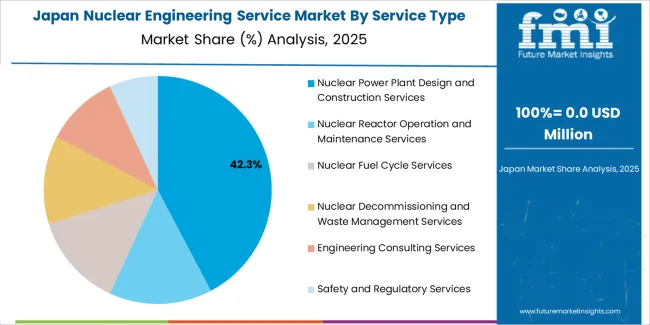
Japan's sophisticated nuclear market demonstrates meticulous engineering service deployment, growing at 5.1% CAGR, with documented safety excellence in reactor operations and industrial applications through integration with advanced monitoring systems and comprehensive emergency preparedness infrastructure. The country leverages engineering expertise in nuclear safety and regulatory compliance to maintain international leadership. Nuclear facilities, including those in Fukushima recovery, Kagoshima, and other prefectures, showcase advanced installations where nuclear engineering services integrate with comprehensive safety platforms and monitoring systems to optimize operational security and performance efficiency.
Japanese nuclear operators prioritize safety precision and regulatory excellence in service selection, creating demand for premium engineering systems with advanced features, including seismic protection and integration with disaster response protocols. The nuclear engineering service market benefits from renewed government support and commitment to nuclear technology that provides energy security and industrial competitiveness.
Market Intelligence Brief:
The Nuclear Engineering Service Market in Europe is projected to grow from USD 7,254 million in 2025 to USD 12,487 million by 2035, registering a CAGR of 5.6% over the forecast period. Germany is expected to maintain its leadership position with a 31.2% market share in 2025, increasing to 32.8% by 2035, supported by its decommissioning expertise and major engineering centers, including North Rhine-Westphalia and Bavaria.
France follows with a 28.5% share in 2025, projected to reach 27.9% by 2035, driven by comprehensive nuclear fleet management and reactor lifecycle programs. The United Kingdom holds a 19.7% share in 2025, expected to reach 20.4% by 2035 through nuclear new build initiatives and advanced reactor development. Italy commands an 8.9% share, while Spain accounts for 6.2% in 2025. The Rest of Europe region is anticipated to gain momentum, expanding its collective share from 5.5% to 6.1% by 2035, attributed to increasing nuclear programs in Eastern European countries and emerging reactor development projects implementing advanced safety systems.
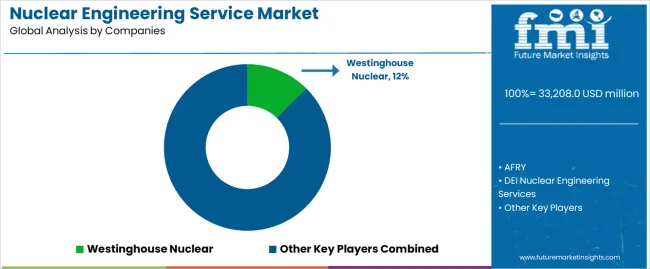
The Nuclear Engineering Service Market operates with moderate concentration, featuring approximately 22-28 participants, where leading companies control roughly 38-44% of the global market share through established engineering capabilities and comprehensive project management expertise. Competition emphasizes safety performance, regulatory compliance, and technical excellence rather than cost-based competition.
Market leaders encompass AFRY, DEI Nuclear Engineering Services, and Westinghouse Nuclear, which maintain competitive advantages through extensive reactor design expertise, global project experience, and comprehensive technical support capabilities that create utility loyalty and support regulatory requirements. These companies leverage decades of nuclear engineering experience and ongoing technology investments to develop advanced reactor systems with exceptional safety and operational features.
Specialty challengers include MNB Precision, Intertek, and Merrick & Company, which compete through specialized application focus and innovative engineering solutions that appeal to niche markets seeking advanced technical capabilities and custom project flexibility. These companies differentiate through operational excellence emphasis and specialized market expertise.
Market dynamics favor participants that combine proven safety performance with comprehensive project management support, including regulatory liaison and international compliance capabilities. Competitive pressure intensifies as traditional engineering firms expand into nuclear specialization. At the same time, technology companies challenge established players through digital instrumentation innovations and advanced monitoring systems targeting emerging reactor segments.
| Item | Value |
|---|---|
| Quantitative Units | USD 33,208 million |
| Service Type | Nuclear Power Plant Design and Construction Services, Nuclear Reactor Operation and Maintenance Services, Nuclear Fuel Cycle Services, Nuclear Decommissioning and Waste Management Services, Engineering Consulting Services, Safety and Regulatory Services |
| Application | Energy, Medical, Industrial, Aerospace and Defense, Research, Government |
| Regions Covered | North America, Europe, Asia Pacific, Latin America, Middle East & Africa |
| Countries Covered | China, India, Germany, Brazil, USA, UK, Japan, and 25+ additional countries |
| Key Companies Profiled | AFRY, DEI Nuclear Engineering Services, Westinghouse Nuclear, MNB Precision, Intertek, Merrick & Company |
| Additional Attributes | Dollar sales by service type and application categories, regional deployment trends across Asia Pacific, North America, and Europe, competitive landscape with engineering firms and technology providers, utility preferences for safety characteristics and regulatory compliance, integration with grid infrastructure and energy systems, innovations in reactor design technology and digital monitoring systems, and development of specialized nuclear solutions with enhanced safety features and operational efficiency |
The global Nuclear Engineering Service Market is estimated to be valued at USD 33,208.0 million in 2025.
The market size for the Nuclear Engineering Service Market is projected to reach USD 64,115.0 million by 2035.
The Nuclear Engineering Service Market is expected to grow at a 6.8% CAGR between 2025 and 2035.
The key product types in Nuclear Engineering Service Market are nuclear power plant design and construction services, nuclear reactor operation and maintenance services, nuclear fuel cycle services, nuclear decommissioning and waste management services, engineering consulting services and safety and regulatory services.
In terms of application, energy segment to command 68.0% share in the Nuclear Engineering Service Market in 2025.






Full Research Suite comprises of:
Market outlook & trends analysis
Interviews & case studies
Strategic recommendations
Vendor profiles & capabilities analysis
5-year forecasts
8 regions and 60+ country-level data splits
Market segment data splits
12 months of continuous data updates
DELIVERED AS:
PDF EXCEL ONLINE
Nuclear Powered Merchant Vessel Market Size and Share Forecast Outlook 2025 to 2035
Nuclear Robots Market Size and Share Forecast Outlook 2025 to 2035
Nuclear Imaging Devices Market Size and Share Forecast Outlook 2025 to 2035
Nuclear Medicine Equipment Market Size and Share Forecast Outlook 2025 to 2035
Global Nuclear Imaging Equipment Market Insights – Trends & Forecast 2024-2034
Nuclear Export Inhibitor Drugs Market
Nuclear Energy Consulting Service Market Size and Share Forecast Outlook 2025 to 2035
Antinuclear Antibody Test Market
Therapeutic Nuclear Medicine Market Analysis – Size, Share & Forecast 2024-2034
Plant life Extensions (PLEX) and Plant Life Management (PLIM) for Nuclear Reactors Market
Engineering Analytics Market Growth & Demand 2025 to 2035
Engineering Plastic Market Analysis - Size, Share & Forecast 2025 to 2035
Engineering Service Outsourcing Industry Analysis in North America Size and Share Forecast Outlook 2025 to 2035
Engineering Service Outsourcing Market Analysis - Size, Share, & Forecast Outlook 2025 to 2035
Geoengineering Market Analysis – Size, Demand & Forecast 2025 to 2035
Civil Engineering Market Size and Share Forecast Outlook 2025 to 2035
Network Engineering Service Market Trends – Demand & Forecast 2025 to 2035
Aerospace Engineering Services Outsourcing (ESO) Market Analysis - Size, Share, and Forecast Outlook (025 to 2035
3D Reverse Engineering Software Market Forecast and Outlook 2025 to 2035
Automotive Engineering Service Outsourcing Market Size and Share Forecast Outlook 2025 to 2035

Thank you!
You will receive an email from our Business Development Manager. Please be sure to check your SPAM/JUNK folder too.
Chat With
MaRIA